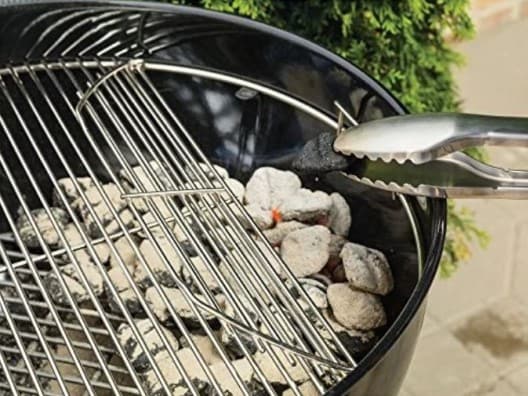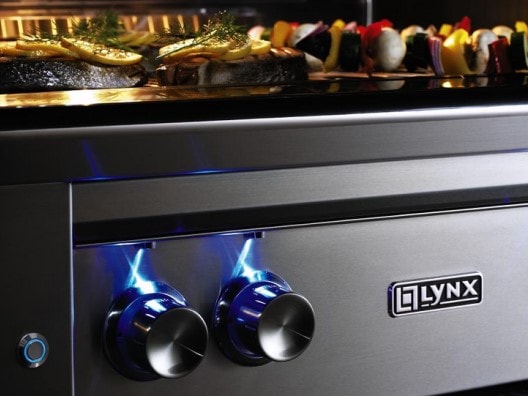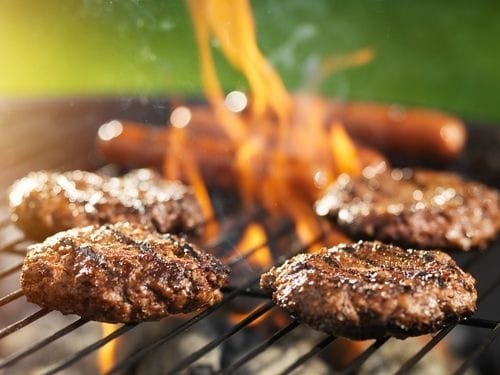Grill Buying Guide
Posted on April 08, 2019 By Rory Keane
When it comes to barbecues and grills there are dozens of options and variations. More choice is always good, but with every new bit of information, your decision becomes a little more difficult. This guide aims to provide you with a simple and to-the-point explanation of various types of grills and features to help narrow your search, bringing you closer to that delicious barbecue you've been dreaming about.
Fuel Type
- Gas (NG/LP): Easy to use, speedy and great for grilling, Gas Grills are well-rounded performers in the marketplace. While the aforementioned traits are what makes gas grills one of the most popular grilling options, it's worth noting that you won't be able to get that signature smoky taste from one due to its fuel type. It's worth noting that when it comes down to propane vs natural gas grills, the main difference it whether or not you have a natural gas line available on your premises for constant use, as opposed to having a refillable propane tank.
- Charcoal: Charcoal Grills remain popular to this day because of their unmatched ability to get hotter than its brethren, allowing it to sear your meals and trap the juices within them. In addition, charcoal grills are also great at imparting that smoky flavor to your meals. That being said, playing with fire isn't all fun and games, as charcoal grills are prone to flare-ups and require frequent cleaning due to charcoal's less-than-clean nature.
- Gas/Charcoal Combo: The best of both worlds. These grills have all the positives that come with both charcoal and gas grills. They tend to be quite large, as each side of the grill is powered by a different fuel type, but the cooking versatility is virtually unmatched. The only notable tradeoff of this almost-perfect combination is that a Gas/Charcoal combo grill can't emulate the flavor produced by a wood pellet grill.
- Wood Pellet: Slow and steady wins the race, at least in some regards. Wood Pellet Grills can create those smoky, melt-off-the-bone meals we all dream about, but the downside to this process is the speed. Wood Pellet grills have a significant startup time compared to other grill types, something worth considering if you host large gatherings.
- Electric: Able to be used indoors and outdoors, an Electric Grill is certainly more versatile than its alternatively fueled peers. Unfortunately, the trade-off for their small size and maneuverability comes at the expense of flavor. Unable to create the smoky, melt-in-your-mouth meals of wood pellet grills or the seared results of a charcoal grill, the electric grill isn't the most flavorful of the bunch, but it is the most portable.
Types
- Freestanding: Making up most of the grill market, freestanding grills are the easiest to repair, come in a variety of sizes and fuel types, and are relatively easy to move around the backyard.
- Cart-Mounted: Similar to freestanding grills, these grills tend to be easy to move around, as well as come in various sizes and fuel types. In addition to those traits, however, cart mounted grills come with a cart that gives you every space to put utensils and plates when cooking your meals.
- Portable: These grills tend to be electric in nature, although high-end charcoal based portable grills do exist. These grills excel at, well, portability! They are excellent for camping trips or tailgates.
- Built-In: Built-in grills are the staple of the outdoor kitchen. These grills are significantly more costly than their freestanding counterparts but are designed to be accessible all year long. Many people believe that cooking outdoors makes their meals taste better, and an outdoor kitchen is the best way to have a full kitchen experience outside of your home.
- Post-Mounted: Post-mounted grills can offer a more affordable solution to someone who wants the experience of an outdoor built-in grill. They can be charcoal based or even gas based, and like built-in grills, they are stationary for easy access all year round.
- Trailer: These grills are essentially freestanding grills that can be mounted to the back of a pickup truck and driven to a specific location. They are very large and might be more suited to catering a large commercial event rather than a more private gathering or family dinner.
Style
- Kettle Grills were invented by George Weber in the '50s. Capable of indirect and direct cooking methods, different Kettle Grills can be fueled by charcoal, wood chips, and even propane.
- Barrel Grills were originally created out of discarded oil drums that were cut in half. In the beginning, they were larger than their Kettle Grill counterparts, but these days they exist in several different sizes. One key difference is that Barrel Grills tend to have a hinged lid, while kettle grills do not.
Size
- Grilling Surface Area/Capacity: Grilling surface area is an important feature to consider when buying your grill. Do you cater for large groups, or do you just cook for yourself? Also, if you get a charcoal grill, a large surface area will enable you to directly and indirectly cook at the same time.
- Number of Burners: The number of burners a grill has is a key feature if you choose to get a propane or natural gas based grill. The burner quantity on a grill usually ranges from 2 burners all the way up 6 to burners. It is important to note that the size of each burner is more important than how many burners a grill comes with. Larger burners mean there is less likely to be cold spots on your grill while cooking. Remember, quality over quantity.
- Burner Output (BTU Power Rating): BTU stands for British Thermal Unit, and it used in the realm of grills to give a rough idea of how hot a grill can get. Take note that BTUs, while a good general indicator of how a grill will perform, aren't fool-proof. More efficient gas grills can still reach the 550-600 degrees F needed to sear meals without having particularly high BTU outputs.

Premium Options
- Side-Burner(s): These are extra burners located off to the side of your grill. They tend to be covered by a small hinged lid, as they are usually used for cooking "extras" in a meal when your main grilling space is full. Such extras include boiling corn, cooking beans, making your own sauces, and more.
- Rotisserie: Included only in premium high-end grills, Rotisseries enable you to cook entire chickens, ducks, or other poultry and meats evenly. By spinning around slowly inside the grill, the food will be cooked evenly on all sides, which leads to juicer meals.
- Searing Station/Burner: Searing Burners are extremely high-performance burners that are used primarily to sear meats. They are different from normal burners because of how hot they are able to get, some are capable of nearly reaching 1000 degrees Fahreinheit. Searing meat allows you to essentially caramelize the outside, trapping the sizzling juices within it.
- Gas-Ignition Charcoal Grills: Gas Ignition on Charcoal Grills becomes more common in higher-end models, as it allows you to ignite your charcoal grill with one press of the button rather than having to use lighter fluid and lighter.
- Smoker Box/Tray: Smoker boxes are relatively small metal boxes or trays that you can fill with various wood chunks to gives your food that extra-smoky flavor.
- Modular Grates: Modular Grates are more common on higher-end models. They enable you to switch between various inserts on your grill - such as a pizza stone, wok, griddle, and more - so you can create almost any meal imaginable.
- Thermometer: Straightforward enough, thermometers tell you the exact temperature inside the grill so you know your meals are cooking properly.
- Temperature Probe: More accurate than a standard thermometer, a temperature probe can tell you the temperature of the food itself rather than just the ambient heat of the grill.
- WiFi/Bluetooth Connected: This feature allows you to check on the temperature inside your grill on your smart device while you go about your business. Some high-end models include this feature, but some mid-tier and entry-level models can be retroactively fitted with these sensors.
- Cook Surface Lighting: This is important if you're cooking at nighttime or in low-light situations. Cook Surface Lights tend to be LED so they are efficient and very bright. Grills with Cook Surface Lighting also tend to include backlit knobs.
- Charcoal Storage: These are convenient compartments that can hold extra charcoal for easy access when grilling.
- Side Shelves: These are shelves so you have more space to work with while your grill. Side Shelves are often collapsible, especially on freestanding grills.
- Casters/Wheels: Self-explanatory enough, wheels and casters make moving your freestanding grill much easier.
- Stainless Steel vs. Enamel Exterior Finish: When it comes to exterior stainless-steel finishes or enamel ones, personal preference is the ultimate decider. Both stainless steel and enamel finishes last a long time and are resistant to harsh elements of nature. Enamel finishes come in a variety of different colors, while stainless steel tends to have a slight upcharge for its higher-end aesthetic.

Cooking Grate Material
- Stainless Steel: Stainless steel grates are easy to clean, require minimal maintenance, and are very durable and resistant to rust compared cast iron counterparts. However, not all stainless steel is created equal, and poor-grade stainless steel can potentially degrade faster than cast iron.
- Cast Iron: Cast iron grates can get hotter than stainless steel grates and last a long time, although not as long as high-quality stainless steel. But in turn, they are more difficult to clean, rust easier, and need a bit more maintenance than stainless steel grates.
- Grill Covers: Grill Covers are relatively inexpensive and very important. They protect your investment and ensure that it lasts as long as possible against the harsh elements of nature. No grill should be left without a grill cover!
Other Options
- Flat Top Grills/Griddles: Flat Top Grills have been around hundreds of years in one way or another. They are a completely flat surface, and are perfect for sauting, stir-frying, and simmering, although nearly any cooking method is possible on them. They are very flexible and more efficient than standard grills as the lack of any gaps on the grate means no heat can escape.
- Smokers: Smoker Grills cook at low temperatures compared to standard grills, at around 300-400 degrees Fahrenheit. They are ideal for cooking ribs and various cuts of seafood, and it gives them that delicious smoky flavor and aroma. It's worth noting that smokers are much slower than a standard grill, due largely in part to the low temperature and indirect cooking method.
- Turkey Fryers: Turkey Fryers are a device used to deep-fry turkeys. This alternative method of cooking a turkey is faster than the more conventional oven method and is becoming increasingly popular in the United States to prepare Thanksgiving meals.
- Kamado Grills: Kamado grills have been around for thousands of years, having been invented in ancient Japan. Kamado grills excel at versatility, as they can be a grill, a smoker, and an oven all at once. They are excellent at holding heat and relatively easy to use; however, they are also quite fragile and very expensive to boot.
If you're still seeking additional information about grills, check out our other educational blogs such as Grills & BBQ Accessories section of our blog, and if you have your heart set on a Weber Grill in particular, head on over to Weber Grills comparison chart. P.C. Richard & Son is here to give you the knowledge to make an informed decision!